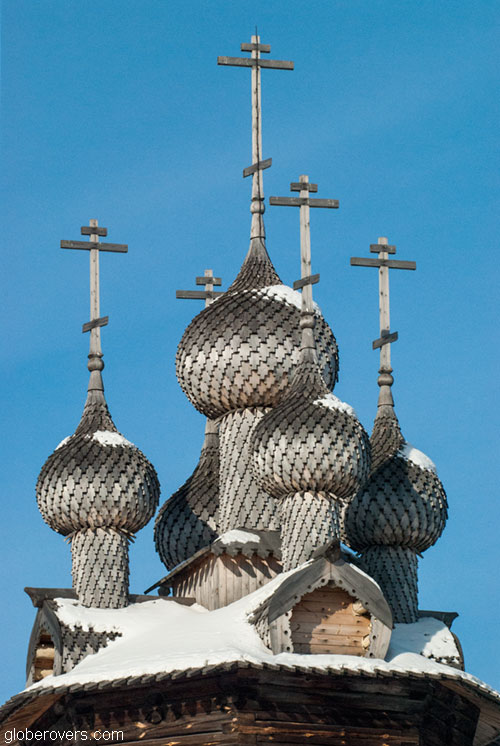
Russia is famous for its onion-domed religious buildings. Northeast of Moscow lies one of Russia’s most iconic regions, aptly labelled “The Golden Ring”, which is a collection of towns known for their spectacular golden onion-domed buildings.
The Golden Ring is roughly a 450 km (280 mi) circle of towns and villages decorated with unique Russian architecture dating from the 12th to 18th centuries, including Kremlins, churches, cathedrals, and monasteries.
Explore this ring of golden domes in the bitter-cold winter to enjoy the best Russia has to offer.
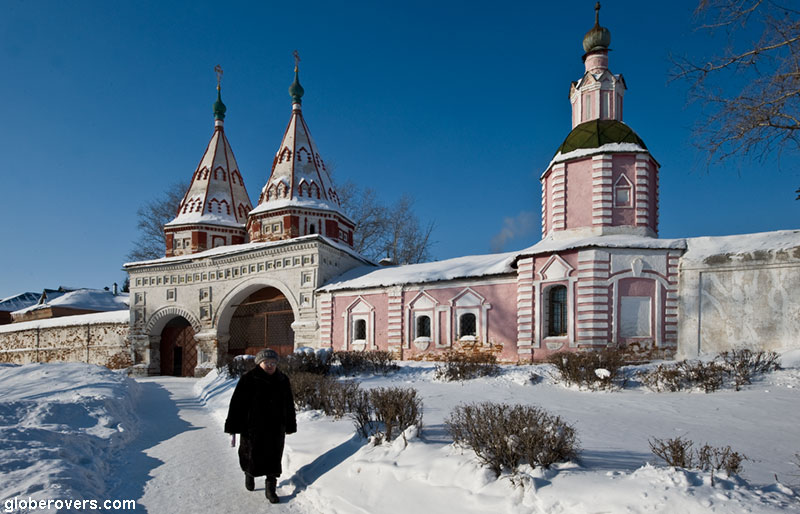
Embark at Moscow’s Kursky Station by train to the town of Vladimir to get your first impressions of Russia’s Golden Ring treasures. From here continue anti-clockwise to Suzdal, Ivanovo, Kostroma, Yaroslavl, Rostov Velikiy, Pereslavl-Zalessky, and Sergiyev Posad. Return to Moscow for more spectacular domes.
Why travel to Russia’s “Golden Ring”
- The low-down: Russia’s Golden Ring is an easy navigatable route, even if you speak no Russian. Come here to experience small-town Russian culture and adore the beauty of the region’s religious architecture. Mid-winter is the most magical time!
- The brightest highlight: The domes and interiors of the churches and cathedrals – absolutely beautiful especially when the domes are dusted with fresh snow! Especially in the town of Suzdal.
- List of highlights in each of the cities along the Golden Ring:
- Vladimir
The first town on the circuit, travelling in an anti-clockwise direction, is the town of Vladimir, which is home to several historical religious buildings. - Suzdal
Suzdal is the gem of the Golden Ring. It is a quaint village with more domed buildings, per capita, than anywhere else. - Kostroma
Located on the banks of the Kostroma River, which flows into the nearby Volga River, Kostroma’s wealth of art and architecture is well known across Russia. - Yaroslavl
As the second-largest city in Central Russia after Moscow, Yaroslavl is located on the banks of the Volga River and has a rich 1000-year old history with ample architectural treasures to explore. - Rostov Veliky
Located on the northern shores of Lake Nero, this is the second prettiest town after Suzdal. The town’s attractions are mainly concentrated within the walled Kremlin. - Pereslavl-Zalessky
Along the southeastern shores of Lake Pleshcheyevo at the mouth of the Trubezh River lies the town of Pereslavl-Zalessky, which has too many beautiful domed buildings to count in one day. - Sergiyev Posad
Near Moscow is the town of Sergiyev Posad with the large walled complex of the Trinity Monastery of St. Sergius and a living centre of Orthodox religion in Russia.
- Vladimir
- Intrepid destination: During winter you will have most of the sights for yourself, and the locals. A great destination for those who seek an emersion in local culture away from the tourist trail. The rest of the year attracts quite a few travellers – local and foreign.
- Globerovers score (10 is highest): The Golden Ring is awesome and gets a score of 9/10.
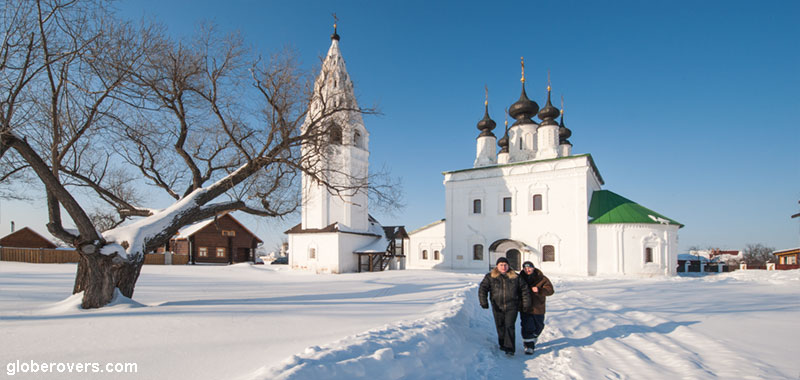
Table of Contents
Cicular Route of Golden Domes
Russia has much to offer to the intrepid traveller and one of the most rewarding destinations is located to the northeast of Moscow. Referred to as The Golden Ring (Золотóе кольцó), the area is comprised of several historic towns famous for their beautiful golden onion-domed religious buildings.

These towns played a significant role in the formation and growth of the Russian Orthodox Church over many years. They have also preserved the memories of some of the most significant events in Russia’s history.
Often described as “open-air museums”, the architecture mostly dates back to between the 12th and 18th centuries. If you are into onion-domed churches, this is the most picturesque collection of towns in Russia to see these architectural wonders.
Golden, green, red and brown domed Kremlins, churches, cathedrals, and monasteries.
Before leaving home, brush up on your Russian, and more importantly your Cyrillic skills. Few people speak English, and the Cyrillic alphabet is used almost exclusively. Without speaking some Russian, it will be very challenging to travel around Russia as people generally ignore English speakers.

The original eight cities officially described as the Golden Ring include Vladimir, Suzdal, Ivanovo, Kostroma, Yaroslavl, Rostov Velikiy, Pereslavl-Zalessky, and Sergiyev Posad. Some lesser famous towns in the circle include Alexandrov, Myshkin, Uglich, Rybinsk and Gus-Khrustalny.
In the functioning religious buildings, limited or no photography is allowed and the Russians strictly impose this ban.
Most of these towns are blessed with domed Kremlins, churches, cathedrals, and monasteries and most buildings are still functioning today, including the monasteries. Don’t expect any ruins or many religious museums. Only a few of the many buildings across the entire Golden Ring are now mainly used as a tourist attraction where entrance and camera fees are charged.
Embark on your trip from Moscow’s Kursky Station from where local trains run a few times a day to Vladimir’s central station.

The train ride takes about 3 hours and passes through some interesting countryside and a few small villages.
Another option is to take a long distance train from either Kursky Station, Yaroslavsky Station, or Kazansky Station. Also, the Moscow-Vladimir special express train takes 30 minutes less, but runs only once a day from Kursky Station. While a few buses also run this route, the train is certainly the preferred option.
Vladimir
Vladimir has a rich history and some of the most spectacular sites include the Cathedral of the Assumption, Cathedral of St. Demetrius, Monastery of Nativity, and Golden Gate.
Vladimir is the gateway to the Golden Ring and is rich in history and architecture
Don’t miss the pretty little red building, which now is called the Museum of Old Vladimir. Most of these buildings are illuminated at night and when covered in snow they are a sight never to forget.

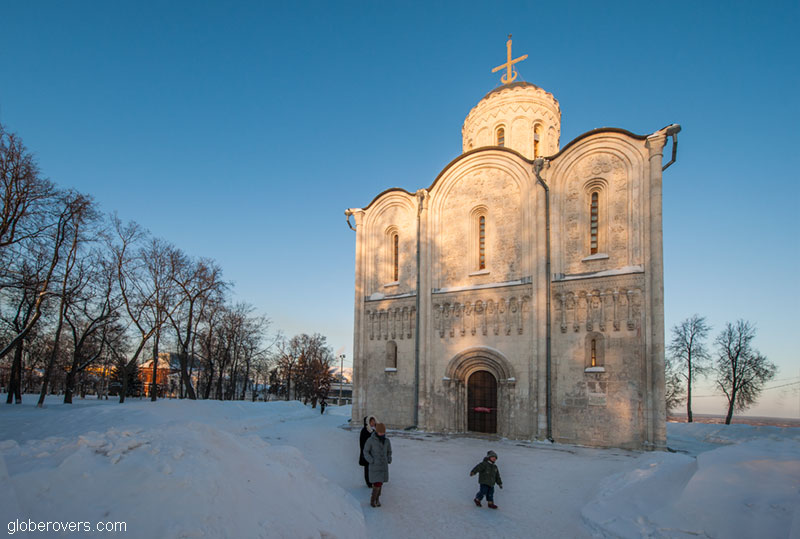
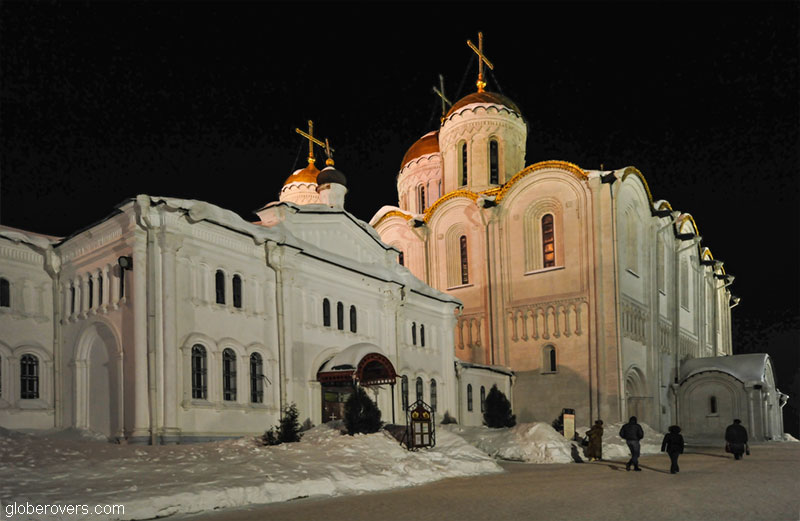

Suzdal
From Vladimir’s bus station a few buses run north to the small town of Suzdal. There are no trains in this direction.
Suzdal is the most beautiful town of the entire Golden Ring. It is a quaint village, rather than a town, and has the most sights per capita than any other town in the Golden Ring.
Suzdal is the brightest highlight among all the highlights of the Golden Ring!
Among the most impressive is the Church of Sts. Boris and Gleb, Church of St. Elijah, Cathedral of the Nativity Virgin (Rozhdestvensky Cathedral), and the Holy Gates at the Monastery of the Deposition of the Robe.

Don’t miss the impressive interior of the Cathedral of the Nativity Virgin (Rozhdestvensky Cathedral), and the prettiest little wooden Church of St. Nicholas, which is typical of Russia’s splendid wooden architecture of the distant past.
For over a thousand years until the 18th century, most buildings in Russia were made from wood, including houses, barns, palaces and of course, hundreds of churches. Working without hammers and nails, carpenters constructed some amazing churches with the most incredible wooden domes showcasing intricate fine wood carving works.


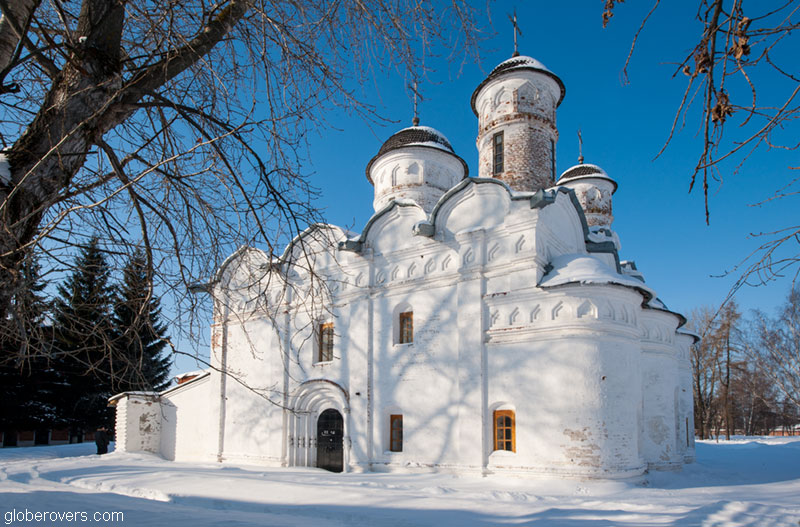






Spend at least three days in Suzdal to enjoy the scenery and the small village atmosphere. People are generally friendly, food is good, and decent accommodation is available such as at the impressive Pushkarskaya Sloboda Resort.
Kostroma
From Suzdal the bus route continues to Ivanovo, which can be skipped if time is limited.
Kostroma, founded in the 12th century, is the next town further north, which is another beautiful town along the mighty Volga River. Much of the older part of town lies on the banks of the Kostroma River which flows into the Volga.
In winter, skate across the frozen Kostroma and Volga Rivers to get around town.
Kostroma’s wealth of art and architecture is well known across Russia. From the historical city centre, called Susaninskaya Ploshchad, the sights fan out in all directions.
Not to be missed are the St. Ipatiev Monastery (known in English as the Hypatian Monastery), the Monastery of the Epiphany, and the Resurrection Church.
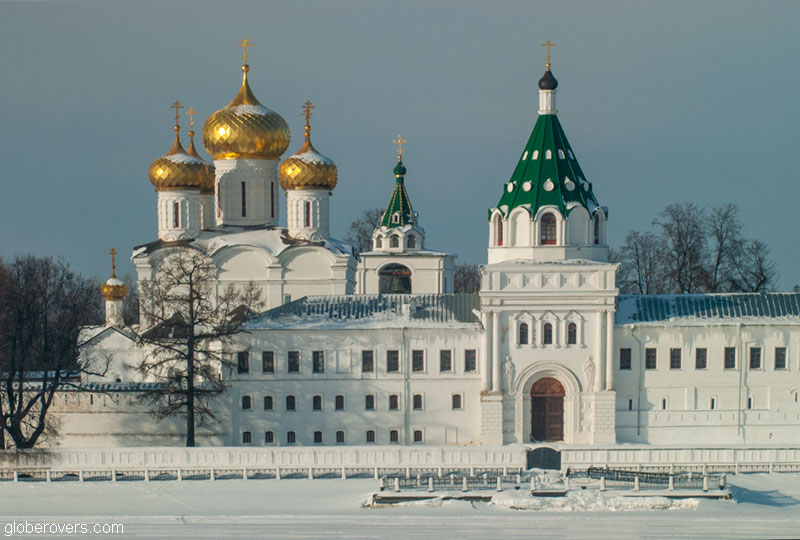
Near the St. Ipatiev Monastery is a beautiful small wooden Church of the Theotokos Cathedral (1552).
In winter the Kostroma River is frozen and can easily be crossed back and forth to the old town.
Kostroma is on the train line to Moscow and the next town of significance, Yaroslavl, is in a southeastern direction.

Yaroslavl
Take either a bus or train to Yaroslavl which is the second-largest city in Central Russia after Moscow.
Located on the banks of the Volga River, the city has a rich 1000-year old history with ample of architectural treasures to explore.
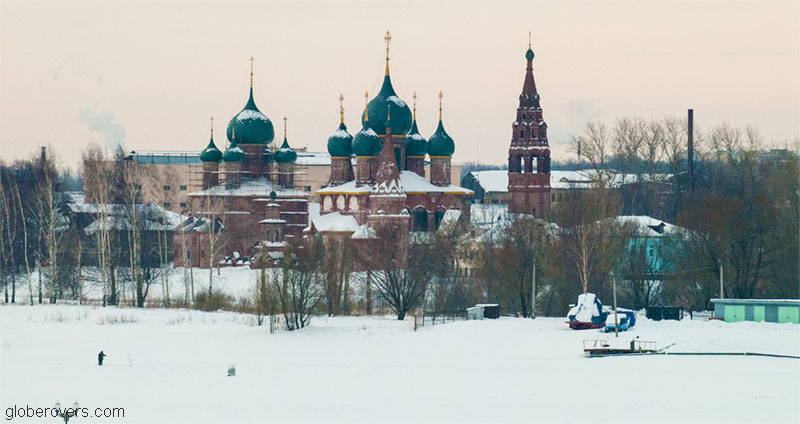
While the important attractions are quite dispersed, long walks can cover most of them. Not to be missed are the Assumption Cathedral, Church of Elijah the Prophet, Sretenskaya Church, Monastery of the Transfiguration of the Saviour, and the Church of Archangel Michael.
It is quite a lively town and just walking around the streets, parks, and markets is an enlightening experience.
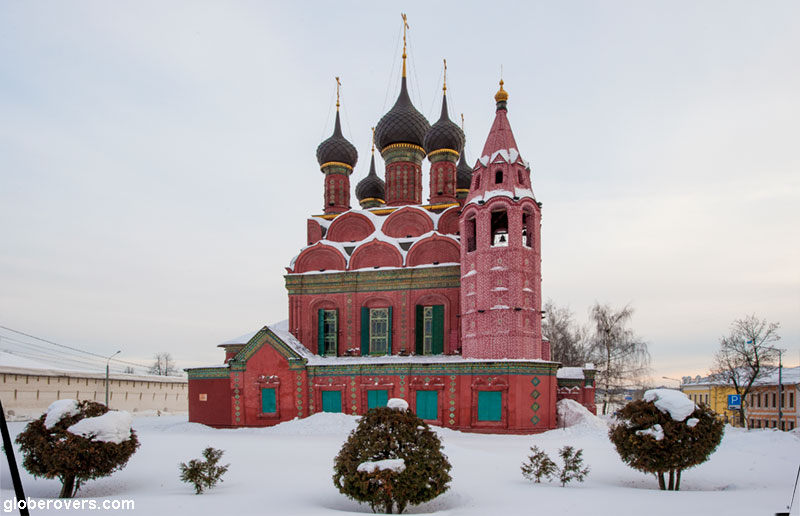

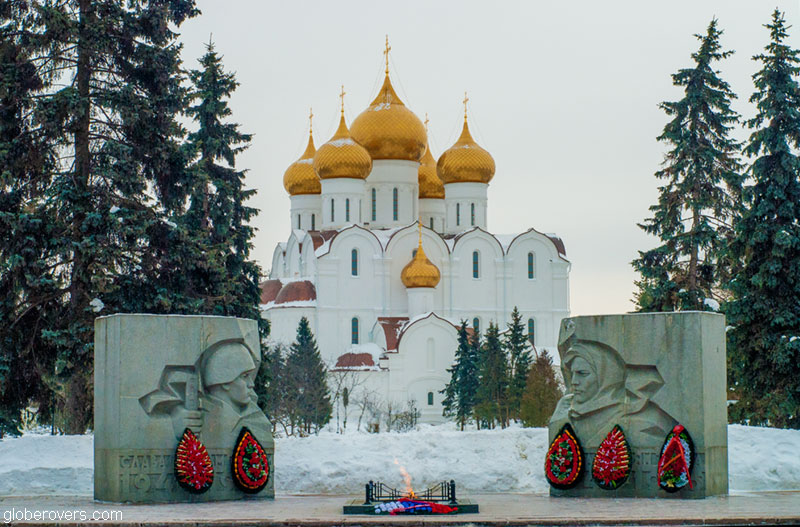
Rostov Veliky
Continue southwest in the direction of Moscow either by bus or train to one of the oldest towns in Russia, Rostov Veliky.
Located on the northern shore of Lake Nero, this is probably the second prettiest town (after Suzdal) in the Golden Ring and the attractions are quite concentrated around the historical walled Kremlin.
The 17th century white walled Kremlin is regarded to be the finest Kremlin outside Moscow.
Behind the walls of the Gate Church of the Resurrection and the Gate Church of the St. John the Devine you will find the Church of Hodigitria and the Dom Na Pogrebakh guesthouse inside the lovely 17th century monastery.


Immediately outside the Kremlin walls are the Belfry and the assumption Cathedral as well as the Church of the Saviour.
A half hour walk further along the shore of Lake Nero lies the impressive Savior (Spaso) Yakovlevsky Monastery, which has been venerated as the shrine of St. Dmitry of Rostov. Also referred to as the Monastery of St. Jacob Saviour it is an Eastern Orthodox monastery founded in the 14th century by St. Iakov of Rostov.
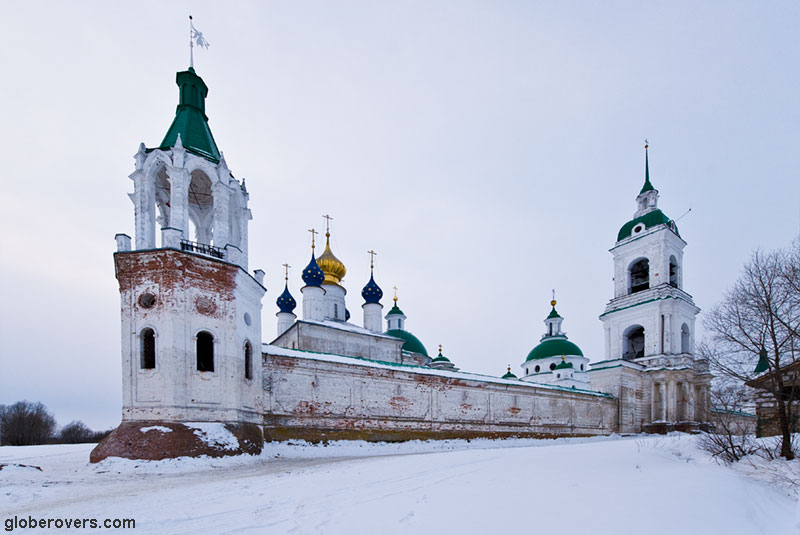
Many of the current structures were built in the late 18th and early 19th centuries in a fine neoclassical style. Inside the walled monastery grounds are two 17th-century churches, namely the Cathedral of Conception of St. Anna and the Savior Transfiguration Cathedral built during the late 1700’s and early 1800’s. Among the many accomplishments of Dimitry of Rostov: he is debatably credited as the composer or compiler of the first Russian opera, which is the six-hour-long “Rostov Mysteries” of 1705.
Further out of town near the river Ishna is the beautiful old wooden Church of St. John of Nazianze. Take a taxi to get to this beautiful wooden church and spend much time just admiring the amazing woodwork.

Pereslavl-Zalessky
The second last town of significance is further down the train tracks towards Moscow and is called Pereslavl-Zalessky.
Located along the southeastern shore of Lake Pleshcheyevo at the mouth of the Trubezh River, the town was founded in 1152 by Prince Yury Dolgoruky.
Just before the Moscow Olympics in 1980, Moscow rounded up many thousands of people it considered ‘undesirable’, and moved them to Pereslavl-Zalessky in order to improve the city’s image.
It was invaded numerous times by the Mongols between the mid 13th century and the early 15th century and during the late 17th century it was a favourite retreat for Peter the Great who built his famous “fun flotilla” on the lake.

The town’s attractions are quite spread out and hiring a taxi for two or three days saves a lot on walking time. In fact, it is quite impossible to cover most attractions on foot. Weather permitting, renting a bicycle would be a good idea, as it would be in all other towns along the Golden Ring.
The town deserves a few days of a traveller’s time as there is so much to see in and around town.
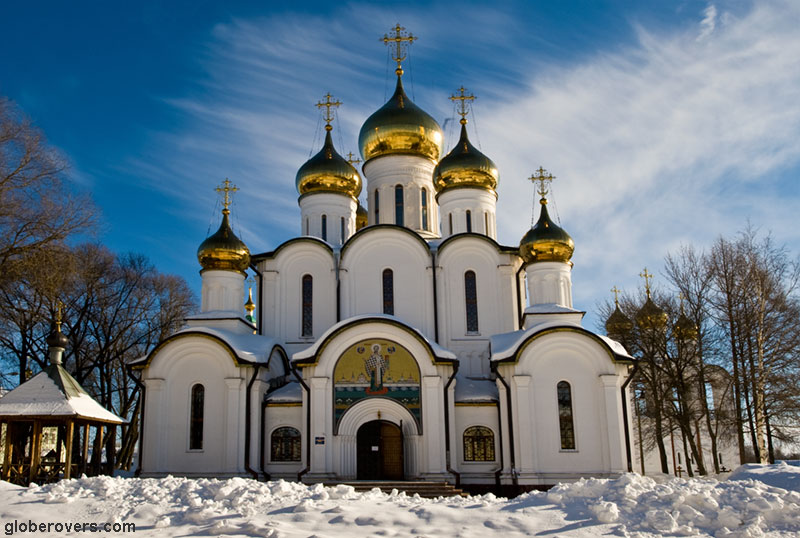

Most of the buildings were constructed between the 16th and 19th centuries.
Among the most beautiful in the centre of town is the Church of Alexander Nevskiy, the Cathedral of the Vladimir Icon of the Mother of God, Cathedral of the Transfiguration of the Savior, and St. Danil’s Monastery of the Holy Trinity.

To the northeast of the town centre is the stunning white St. Nikita Cathedral and Monastery.
East of the centre, on the lakeshore, is the Church of the Forty Martyrs. Nearby are the St. Nicola Convent, Znamenskaya Church (The church of our Lady of the Sign) and the bright orange coloured Church of the Intercession.


To the south of town is the impressive Goritskiy Monastery complex, the blue-domed Church of the Purification of the Blessed Virgin Mary, and the St. Theodore Convent with a beautiful old wooden house on-site.

Sergiev Posad
Continue by train towards Moscow to the last town, Sergiev Posad.
The main feature of this town is the huge walled complex of the Trinity Monastery of St. Sergius. Within these walls are the blue and gold domed Assumption Cathedral and its impressive Bell-tower, the Trinity Cathedral, and many other impressive historical buildings.
The Trinity Monastery of St. Sergius is also referred to as Trinity-Sergius Lavra. As an outstanding example of 14th to 18th-century Russian architecture, it served as a model for later designed buildings across Russia.
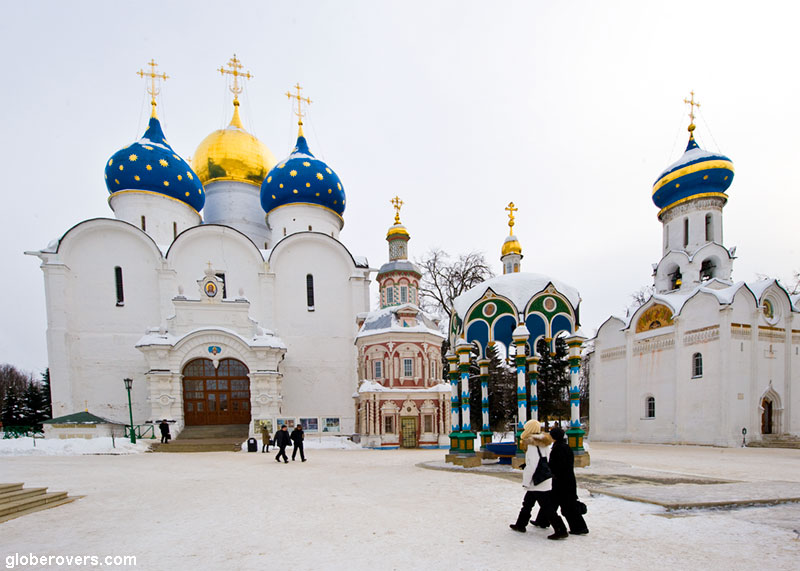
North of the Trinity Monastery is the pastel blue coloured Church of Peter and Paul, as well as the Church of the Virgin of Smolemsk, and the little St. Paraskeve Pyatnitsa Well Chapel.

Sergiev Posad is the holiest of all the towns around the Golden Ring. While the Trinity Monastery is worth visiting, the rest of the town does not have much to offer.
By the time you are done with Sergiyev Posad you will be quite onion-domed-out for a while. Get back onto the train and within a short time you will be back in Moscow just in time for ballet at the Bolshoi Theatre.
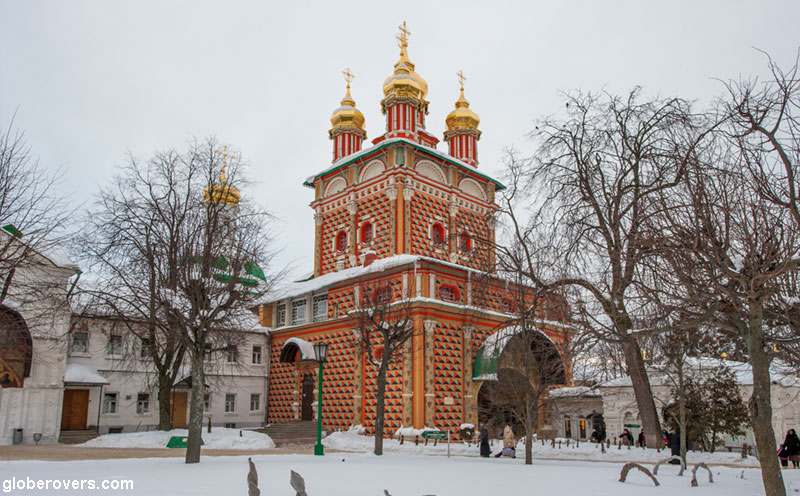
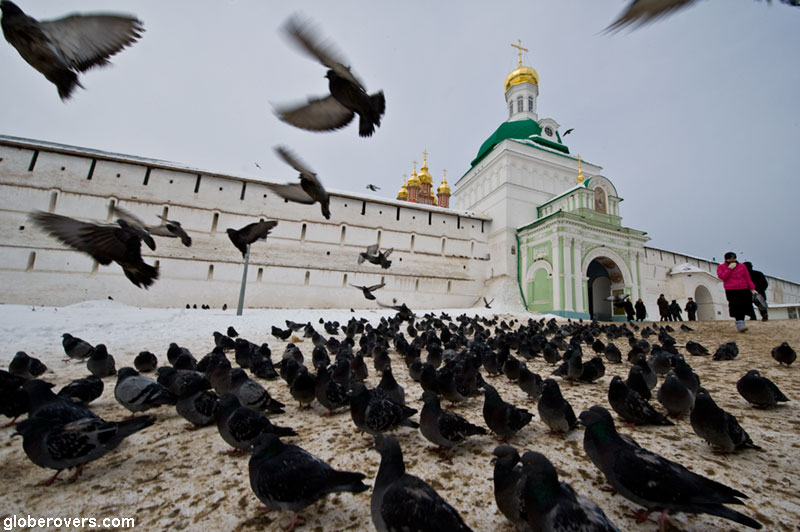
Essential Information
Getting There
To get to this region, first fly into Moscow from where trains and buses, or private cars, travel into the Golden Ring area.
When to Go
While summers are warm and green, the most spectacular sights are in winter when the beautiful domed buildings have a fluffy covering of snow. Be here from late December to early March to enjoy winter among the golden domes. Be warned that winters get bitterly cold.
Getting Around
From Moscow several buses and trains travel to the first town,Vladimir. From here, only buses and shared taxis travel to Suzdal and onwards to Kostroma. From Kostroma, which is back on the train line to Moscow, travellers have a choice to reach the remaining towns by bus or train. Of course, there is always the option of a private car, preferably with a good local driver.
Where to Stay
A wide selection of hotels, guesthouses, and home stays are available along the Golden Ring, with the typical cold Russian reception.
Cost of Travel
Travelling in Russia is not particularly cheap, though travels around villages are cheaper than in large cities such as Moscow and St. Petersburg.
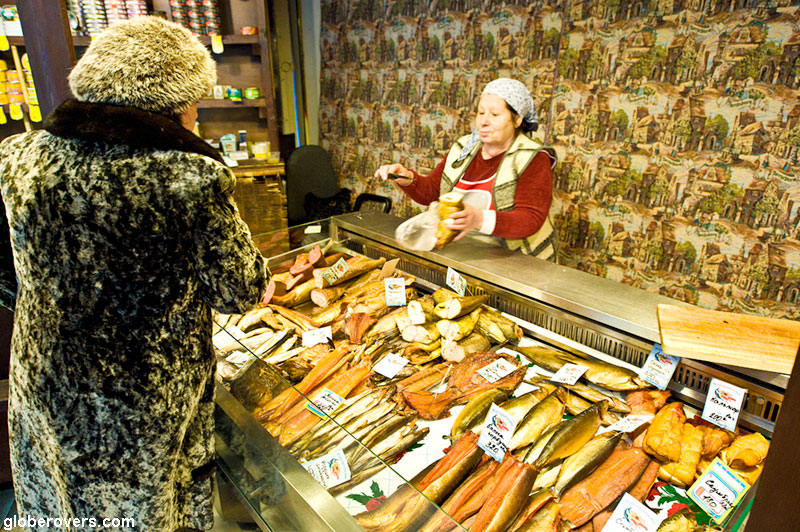
☛ Read more: Blog posts about Russia

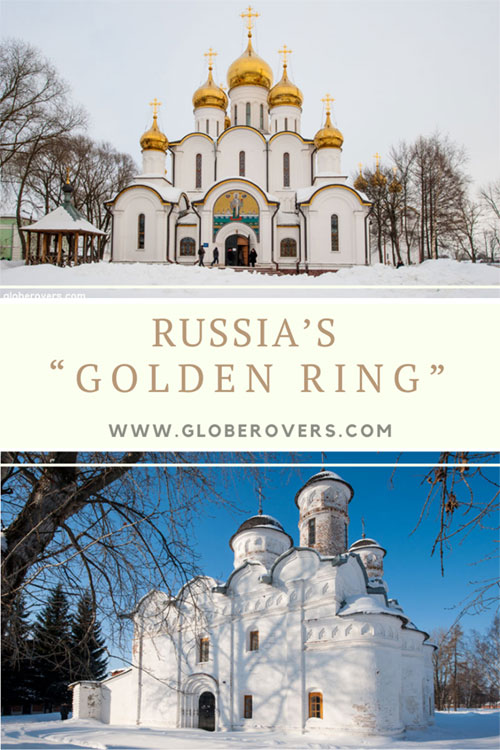

Blog post and photos by Peter who has been travelling almost full-time since 2005 and has been to over 122 countries. He visited several countries, such as Japan, more than 20 times. Peter is Editor-in-Chief and Publisher of GlobeRovers Magazine, an independent travel magazine focused on intrepid destinations.


